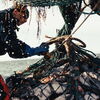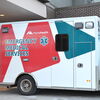JAX mice are rocketing to International Space Station
 Courtesy / The Jackson Laboratory
Jackson Laboratory scientist Se-Jin Lee and Emily Germain-Lee with Connecticut Children’s Medical Center are leading a project that’s sending a cohort of JAX mice to the International Space Station.
Courtesy / The Jackson Laboratory
Jackson Laboratory scientist Se-Jin Lee and Emily Germain-Lee with Connecticut Children’s Medical Center are leading a project that’s sending a cohort of JAX mice to the International Space Station.
A batch of mice bred by Jackson Laboratory, headquartered in Bar Harbor, will be traveling to the International Space Station next month.
The mice are part of a 40-day space mission expected to help scientists understand more about bone and muscle loss in both astronauts and earthlings who suffer from diseases such as ALS and cancer, as well as the general effects of aging, according to a news release.
The project’s principal investigator is Se-Jin Lee of JAX, who received a grant from the Center for the Advancement of Science in Space to conduct experiments onboard the station during its mission from December to January. The research team includes scientists from JAX, the University of Connecticut School of Medicine and Connecticut Children’s Medical Center.
JAX has dubbed the cohort of animals “Mighty Mice.” Lee will attend the launch. NASA astronaut Jessica U. Meir, who is from Caribou and recently participated in the first all-female spacewalk, will be onboard the station and working with the mice.
The lab's mice have previously been utilized in projects at the International Space Station, JAX spokeswoman Grace Scott told Mainebiz by email.
NASA’s projected launch date is Dec. 4, but is subject to weather and other uncontrollable conditions, she added.
Preparing for launch
“Mighty Mice” are genetically engineered mouse models that lack myostatin, a protein that limits muscle growth, and therefore display increased muscle mass. Lee discovered myostatin in 1997, and the breakthrough is considered a milestone in aging and disease research, according to the release.
The mice can be used to model the clinical effects that myostatin inhibitors have on muscle and bone loss, particularly related to disuse.
“This study will relate to humans who suffer from disuse-related muscle loss, like the elderly or bed-ridden,” Scott said.
How are the mice prepared for launch?
“They arrive at the launch site several weeks ahead of launch to become accustomed to the habitats, food and water that sustain them during their time in orbit,” she said. “Any mice that experience difficulty adapting to the new conditions or show signs of distress prior to launch are excluded from the flight cohort.”
How do they eat and sleep in space? With regard to sleep, it varies, she explained.
“But that is part of the adaptation process of living in microgravity,” she continued. “The mice are group housed on orbit in groups of five to 10, as mice are social animals. The habitats currently include a small hut that enables the mice to huddle and sleep together.”
For food, rodent food bars are available for the mice to eat.
“Food and water are provided to the mice on orbit in excess so that they can eat, drink and sleep as they choose,” she said.
During spaceflight, mice engage in normal activities related to feeding, grooming, and interacting with other mice, according to NASA article published in April that explains how mice adjust to microgravity.
The rodents quickly adapt to weightless circumstances. For example, they anchor themselves to the habitat walls with their hind limbs or tails.
Student partnerships
In addition to the science, Lee will engage with students from two public high schools in Hartford, Conn., throughout the project so they can analyze the data and make predictions about the mission. Future plans include bringing the STEM learning experience to schools in Maine and beyond, said Scott.













0 Comments